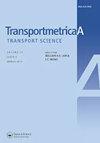Convexity and global optimisation of lane-based fixed-time signal model for delay minimisation at an isolated intersection
IF 3.1
2区 工程技术
Q2 TRANSPORTATION
引用次数: 0
Abstract
Lane-based fixed-time signal is basic to various signal control strategies. It performs well in maximizing road capacity, but is faced with significant challenge in minimizing traffic delay. This study validates the convexity of lane-based fixed-time signal model for delay minimization, when lane markings are determined as well as flow factors. Thus Breadth first search algorithm is developed to enumerate the feasible lane markings, which are then screened with flow factors. Cutting plane algorithm is applied to the CMINLP for each feasible lane markings, where the non-linear delay function is converted to a series of linear ones, until the relaxed delay converges to the actual delay. Branch pruning strategy is established for efficiency, to eliminate the lane markings with uncompetitive delay. Numerical analyses follow to validate the proposed algorithm. This research promotes the redesign of lane-based fixed-time signal control.
基于车道的隔离交叉口延迟最小化固定时间信号模型的凸性与全局优化
基于车道的固定时间信号是各种信号控制策略的基础。它在最大化道路容量方面表现良好,但在最小化交通延误方面面临重大挑战。本研究验证了当车道标线和流量因素确定时,基于车道的固定时间信号模型的延迟最小化的凸性。为此,提出了宽度优先搜索算法,以枚举可行的车道标记,然后用流量因素对其进行筛选。对每个可行的车道标线对CMINLP进行切平面算法,将非线性延迟函数转换为一系列线性延迟函数,直到松弛延迟收敛到实际延迟。为了提高效率,建立了分支修剪策略,以消除具有非竞争延迟的车道标线。数值分析验证了算法的有效性。该研究促进了基于车道的固定时间信号控制的重新设计。
本文章由计算机程序翻译,如有差异,请以英文原文为准。
求助全文
约1分钟内获得全文
求助全文
来源期刊

Transportmetrica A-Transport Science
TRANSPORTATION SCIENCE & TECHNOLOGY-
CiteScore
8.10
自引率
12.10%
发文量
55
期刊介绍:
Transportmetrica A provides a forum for original discourse in transport science. The international journal''s focus is on the scientific approach to transport research methodology and empirical analysis of moving people and goods. Papers related to all aspects of transportation are welcome. A rigorous peer review that involves editor screening and anonymous refereeing for submitted articles facilitates quality output.
 求助内容:
求助内容: 应助结果提醒方式:
应助结果提醒方式:


